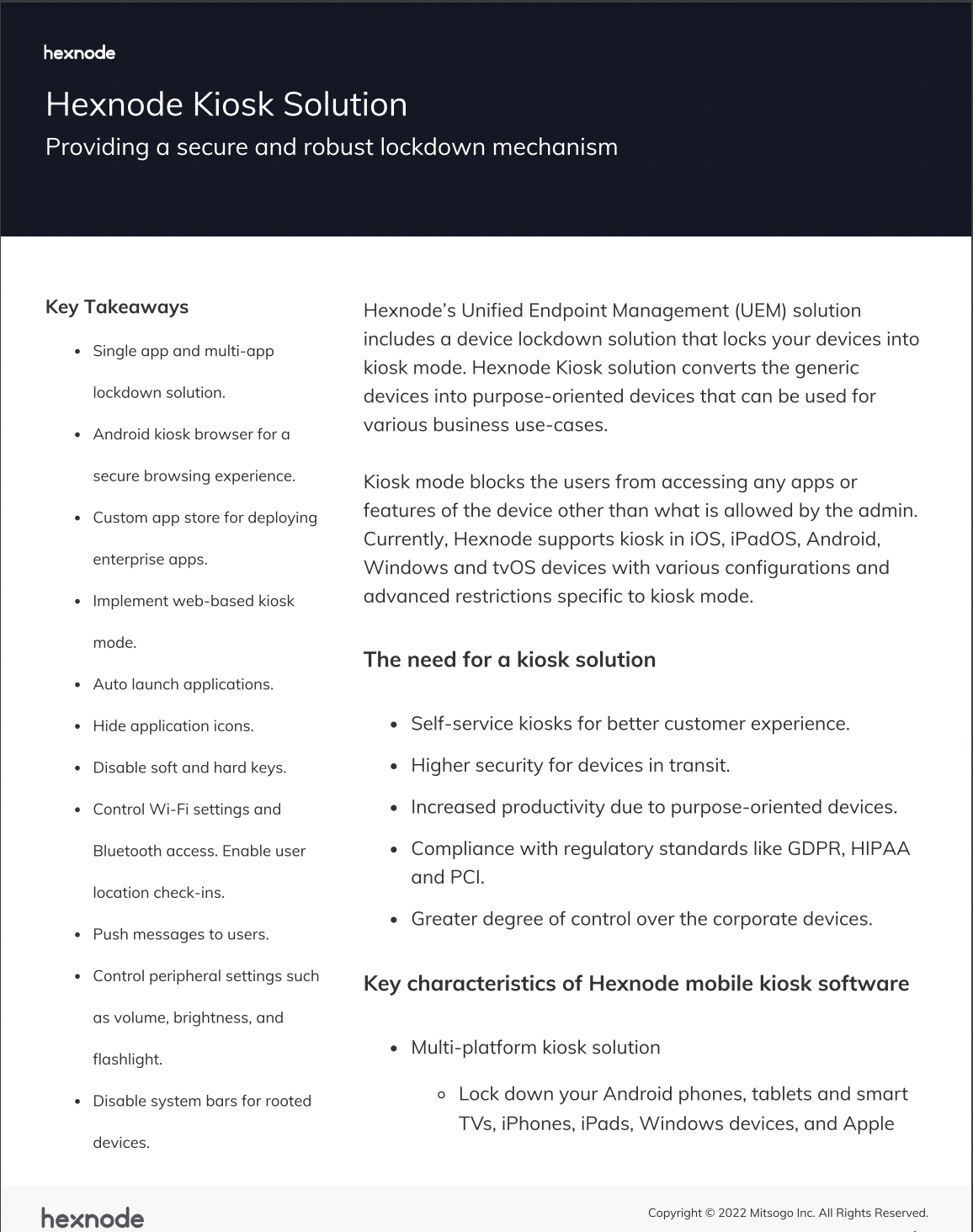An IT manager's guide to Fire OS management
Let’s have a look at the differences between Android and Fire OS and learn how to manage Fire OS with Hexnode UEM.

Get fresh insights, pro tips, and thought starters–only the best of posts for you.
Lizzie Warren
Mar 22, 2023
10 min read

Let’s just imagine running a bustling restaurant with Fire OS kiosk devices. It helps customers to place orders quickly and efficiently. However, as much as they appreciate the convenience, they are understandably worried about the potential security risks associated with these devices. You wouldn’t want your customers to feel worried or uncomfortable while making transactions at your kiosks, right? So, how can you make sure that your kiosks are secure and your customers feel safe? 🤔
No worries, we will help you! Let’s delve into the world of Fire OS kiosk security, exploring the most common risks and sharing the best practices to keep you secure and protected in any kiosk scenario. So read on to discover everything you need to know about Fire OS kiosk security.
Businesses usually face difficulties in keeping their Fire OS kiosk mode secure even after implementing the latest security measures and best practices. Furthermore, it’s a common challenge that many face in today’s ever-evolving digital landscape. As mentioned before, some of the security challenges of using Fire OS kiosk mode are as follows:
One of the most frequent security issues for kiosks is unauthorized access to the device. For instance, attackers can take advantage of weaknesses in the system or employ brute force attacks to gain access to the device, potentially compromising sensitive information and creating a significant security risk.
Kiosks are susceptible to malware and hacking attacks that might jeopardize the device’s security or collect personal information. Hence, businesses should be always vigilant in monitoring and protecting their devices from these types of attacks to ensure the safety and security of their data.
Another security risk that enterprises should consider is physical damage or theft of the device. Unsecured kiosks are easy targets for theft or damage, consequently resulting in data loss or unauthorized access.
As with any software, compatibility issues can arise between different apps and programs running on the kiosk. Moreover, these issues can potentially compromise the security of the device. Therefore, the organization should address them promptly to prevent any vulnerabilities from being exploited.
One of the most overlooked security risks for Fire OS kiosks is human error. In fact, this can range from users accidentally downloading malware to carelessly leaving the device unattended in a public space. Businesses need to educate their employees on best practices for using and securing kiosk devices.
To address vulnerabilities and guarantee their continued security, kiosk devices, like any other technology, need regular upgrades. A lack of regular updates can leave the device vulnerable to potential security threats, and hence businesses should ensure that their kiosks are up to date with the latest patches and updates.
If a business uses third-party apps on their Fire OS kiosk, they must ensure that those apps are secure and not posing any risks to the overall security of the device. Vetting third-party apps for security vulnerabilities and keeping them updated is vital to ensuring a secure kiosk environment.
Get a glimpse of how easy it is to achieve a purpose-specific environment in your organization with Hexnode.

Featured resource
Hexnode Kiosk Solution
In the ever-evolving landscape of cybersecurity, there will always be vulnerabilities waiting to be discovered and exploited by cunning hackers. But rather than living in fear of these threats, businesses should take the initiative and equip themselves with the ability to eliminate security vulnerabilities.
Hexnode UEM is the best option to turn the tables on hackers and take control of our kiosk security. This solution offers kiosk management for Android devices, including Amazon Fire tablets. Kiosk mode locks down the device, particularly ensuring greater device security and efficient management. However, Hexnode goes beyond kiosk mode to offer other features that contribute to better security and management.
Its features include:
Hexnode UEM offers many additional kiosk setup choices in addition to the functionalities already described. You may easily restrict access to numerous apps in addition to locking down your device to just one.
The Fire OS device from Amazon offers the option to lock down the device into a single application or file. This feature allows users to restrict access to other apps and content on the device. Additionally, we can use the App Testing Service (ATS) to check the compatibility of your Android app with the Amazon Fire Tablet.
To increase security, policies can be configured to set kiosk exit password, relaunch app option and scheduled refresh option via Hexnode. Peripheral controls such as volume and brightness can also be restricted, and network access can be limited. And the best part? All these can be done through a single policy.
Furthermore, you can hide background apps without any user interference through app configuration settings. This ensures that the user’s focus remains on the intended application or content without any distractions.
The Multi App Kiosk Mode allows for limiting user access to a select few crucial applications or file shortcuts. It also enables the configuration of network settings, app restrictions, and peripheral settings. This feature is particularly useful in situations where the device is used by multiple users or when the device is used for a specific purpose, such as in a public display setting.
With Web app kiosk mode, users can lock Amazon Fire tablets to single or multiple web apps by adding web URLs to the Hexnode Web Console. The Hexnode Kiosk Browser can be used to open the configured web apps and whitelisted web URLs. The browser supports both single and multi-tabbed browsing, providing users with flexibility in their browsing experience.
In this mode, Businesses can upload audio, images or videos from the Hexnode File Manager to specified Fire OS devices and play them either in a loop or as a static display. The IT admins can also play these images in shuffle mode for added variety. This makes it possible to remotely change the brightness and orientation of the screen. Additionally, users can schedule the device to enter sleep mode after playing a specific number of image loops. JPG and PNG for photos, MP4 and Matroska (MKV) for movies, and MP3 and OGG for audio are the supported file types for media files.
In today’s world, businesses must prioritize the security of their devices, especially those that handle sensitive information. Those who wish to manage their devices and restrict user access can utilize Fire OS kiosk mode, but it has security issues that need to be addressed. By utilizing the best security standards and Hexnode UEM’s kiosk management capabilities, businesses can enhance their security measures, enabling improved device security and simplified management.
So, whether you’re setting up digital signage, interactive kiosks, or point-of-sale systems, don’t forget to prioritize security. Secure your Fire OS kiosk devices for peace of mind! Don’t wait, take action now and safeguard your kiosk devices! Also share this blog with your friends to help them secure their devices! Stay safe and stay tuned for our next post. Goodbye! 👋🏻
Start your 14-day free trial to experience the very best of kiosk management with Hexnode.
SIGN UP NOW